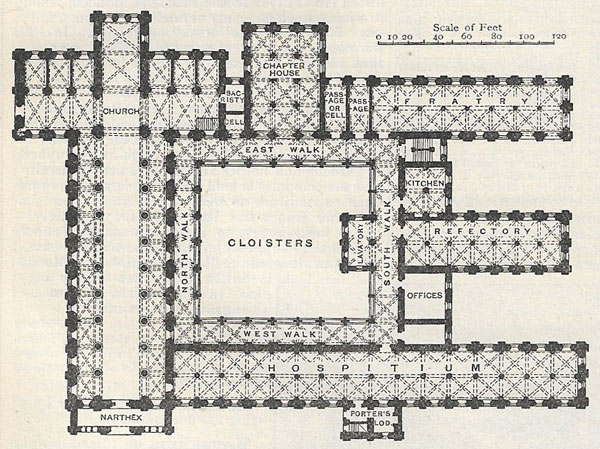monastery

Figure 1. Plan view of a Cistercian abbey
A monastery is a class of structures which arose in the middle ages to meet the requirements of the large number of monks that then existed. Monasteries were at first built somewhat along the lines of a Roman house, or rather of a Roman villa or country house. Records of abbeys as early as the 7th century show that the arrangements were similar then to those of the 12th century. The cloister, which formed the inner court appropriated to the monks, resembles the peristyle of the Roman mansion. The latter was the part of the dwelling communicating with the private apartments of the family, just as the cloister communicated with the refectory, dormitory, and other apartments used by the monks and not entered by the public. There was also in the monasteries, as in the Roman villas, an outer courtyard, in which were situated the various stores, granaries, workshops, and other places required in connection with both these edifices.
There was, however, one entirely new element in the monastery, namely, the church. This was the largest and most important building, and regulated the position of all the rest.
Consider the arrangements of the Cistercian abbey in the twelfth and thirteenth centuries (Figure 1). In northern climates the cloister was usually situated on the south side of the church, for the sake of the sunshine and warmth. It was composed of an open courtyard, square or oblong in shape, surrounded by an open arcade, or covered way. The church formed the north side, and on the east side was the chapter-house, with the monks' dormitory over it. The latter was thus in immediate communication with the church, and conveniently placed for the monks' attendance at the services during the night. The chapter-house in the Cistercian monasteries was usually divided into three compartments by the pillars bearing the arches. The abbot's seat was opposite the entrance door, and a stone seat all round accommodated the monks. The doorway was not closed, and together with an open arch or window on each side of it allowed those in the cloister to hear the discussions in the interior. The sacristy is placed on the north side of the chapter-house, with a door from the church. A similar cell or "parlor" occupies the south side; then comes a passage of "slype" leading from the cloister to the gardens, etc. Beyond this is fratry or day-room of the monks, a long vaulted apartment running southwards, having a row of columns in the center and open windows.
The south side of the cloisters generally gave access to the refectory, a large, rather ornamental chamber, usually with an open wooden roof. It was sometimes placed parallel and sometimes at right angles to the cloister. Opposite the door to the refectory and in a vaulted recess stood a fountain or basin where the monks might wash. Adjoining the refectory were the kitchen and offices. The former was frequently a detached building with a large number of hearths, each having a separate chimney in the roof. Along the west side of the cloister, and sometimes extending much farther, lay the hospitium or guest-house, where all travelers were received, and the lay-room above, where they were lodged.
A very important room in the monastery was the scriptorium or library, in which the manuscripts were written and illuminated; this was situated on the second floor of the chapter-house. The abbott's lodges formed a separate edifice, as also did the infirmary. The whole establishment was surrounded by a wall, and provided with proper gates and defenses. The outer gate gave access to the outer court, in which were situated the workshops of the various tradesmen connected with the abbey, and the buildings required in connection with the agricultural employments of the lay brethren.
In later times the simplicity of the plan was broken. The monks, wanting more comfortable quarters, divided the dormitory and made it into cells. The open windows were glazed, and even the arches of the cloisters were sometimes enclosed. The early simplicity of the architectural style was also departed from, and the monastic buildings of the fifteenth century are as rich in decoration as the cathedrals and parish churches.
The arrangements of the monasteries of the other orders were, generally speaking, similar to those of the Cistercian, except in the case of the Carthusians. In their convents, where absolute solitude and silence were required, each monk had a small house and a garden to himself. These were arranged around the cloister, which, when the number of monks was large, were greatly extended in dimensions.
